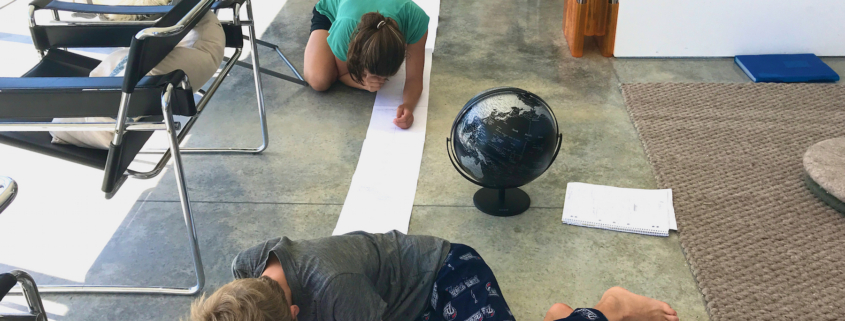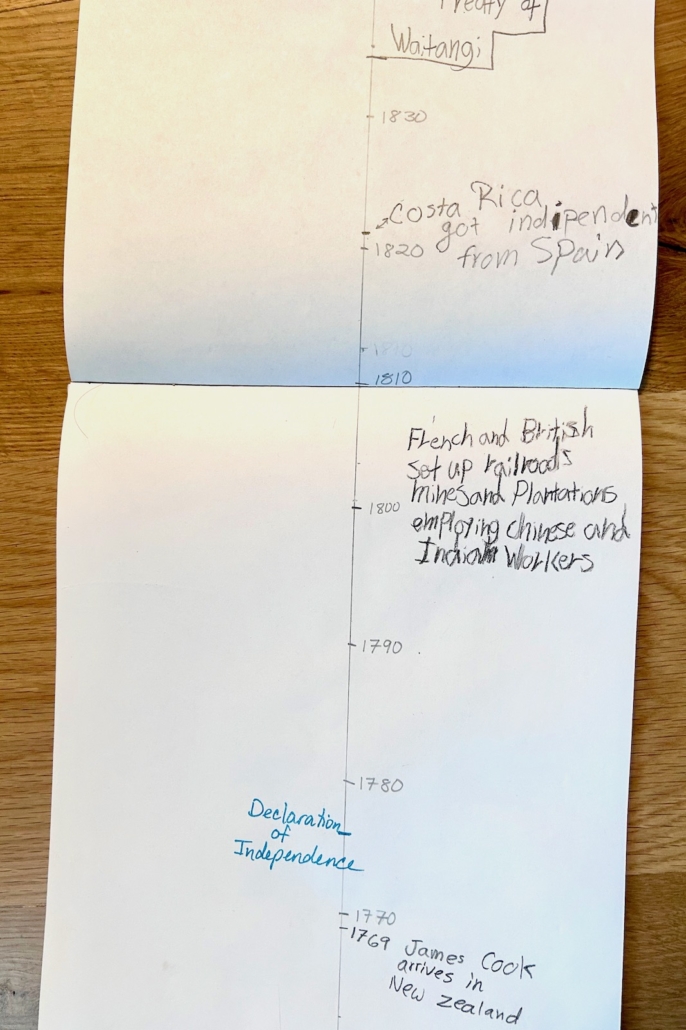Traveling Timelines
This blog is not about travel logistics, but rather those old-school timelines you might have made in school. As an easy graphic organizer, traveling timelines are especially helpful for worldschooling families. Here is some inspiration for how and why you might use pencil and paper timelines in your worldschooling curriculum.
Merriam-Webster says that a timeline is, “a table listing important events for successive years within a particular historical period.”
According to Wikipedia, “a timeline is a visual representation of a chronological sequence of events along a drawn line that helps a viewer understand time relationships.”
I decided to create and bring a traveling timeline with us on our travels rather serendipitously. As I was preparing for our Wonder Year, my third grader, Lucy, asked the question, “did Grandad know Moses?” As a mom trying to help my own kid, I played to Lucy’s visual and spatial skills by creating a timeline with paper and string that went down the street. We counted an inch for each decade and went all the way to Moses. On a whim, I brought that timeline along on the trip and it became a powerful learning tool.
You see, most worldschooling families find history and social studies spectacularly easy to learn. If you’re in Egypt, history comes alive when you’re walking alongside the pyramids and inside the temples. Learning about pharaohs and hieroglyphics is part of the journey. The challenge is that that learning is not chronological. Kids can become confused about the order of events. What came first? The Pyramids of Giza, the Declaration of Independence, The Donner Party or World War II? Are there hundreds of years between these events? Or thousands of years? It might seem obvious to adults, but we have a conceptual framework to hang our learning upon.
Social studies curricula in a traditional classroom are built chronologically (but jump around by location), and the events can be arranged as cause and effect. Worldschooling itineraries are not chronological and events can seem disparate and isolated. By introducing traveling timelines we can help our kids (and ourselves) see how events match up and begin to recognize themes and cause and effect relationships. A win-win!
Building a Timeline Together
I’m sure there are many ways to create a timeline, but here’s what worked for us. We laid out a series of 8.5” x 11” papers in the landscape orientation, and without overlapping the edges, we taped them end to end so that we could fold it up easily, creating a hinge with the tape strip. With a ruler, we drew a line right down the middle. We then measured one inch for each decade and began marking them IN PENCIL. Trust me, there will be slip-ups when you’re working backward. We double-checked each other.
Our endpoint was 2000 BCE, but that decision is totally subjective. Sometimes, when we were looking at ancient or geologic time, we used string with a piece of masking tape to mark each hundred or thousand years. We ran this behind our paper timeline to get a sense of the scale. We could then visually estimate how far back paleolithic people, dinosaurs, or Pangea might have been.
New technology and diagramming programs might be able to help your timeline be more travel-friendly. You can extend it further and use this as a graphic design lesson or digital arts opportunity. Word, for example, has a timeline feature under SmartArt, then Process, then Timeline. Canva also has multiple templates. Other business programs have project management tools that come with free trial memberships or various pay-to-play tiers. Both smartsheet and edrawmax look fun to explore.
For us, the hands-on creation was part of the fun. And something as abstract as time could be made manifest in its tangibility. We carried a hard shell accordion folder and could easily fold this up for transport.
Learning Standards covered
We might think of timelines as solely part of a Social Studies curriculum, but they can be so much more. Here are teasers of how you might use a timeline to meet learning standards for multiple subjects. Not that you need to be this granular in your worldschooling, but this specificity might help show how this could fit in your overall experiential learning plan. Perhaps it might inspire you to extend a timeline into other subject areas or articulate what else you all are learning.
Historical Thinking
- view chronology and cause-effect relationships
- look for influential events
Math Skills
- use numerical values and mathematical concepts to represent dates and time spans on the timeline
- understand units of time, intervals, and scaling on the timeline
Information Skills
- gather information about events, dates, and historical figures to include in your timeline
- evaluate the credibility and reliability of sources when researching historical events
Art Skills
- choose images or logos to represent places or events
- play with color, shading, borders, and other design elements
- use digital programs to draw your timeline
Critical Thinking / Problem-Solving
- decide how to represent time spans effectively
- conceive what should be on the timeline
- hypothesize cause and effect relationships
- predict which patterns might be repeated (more on this below).
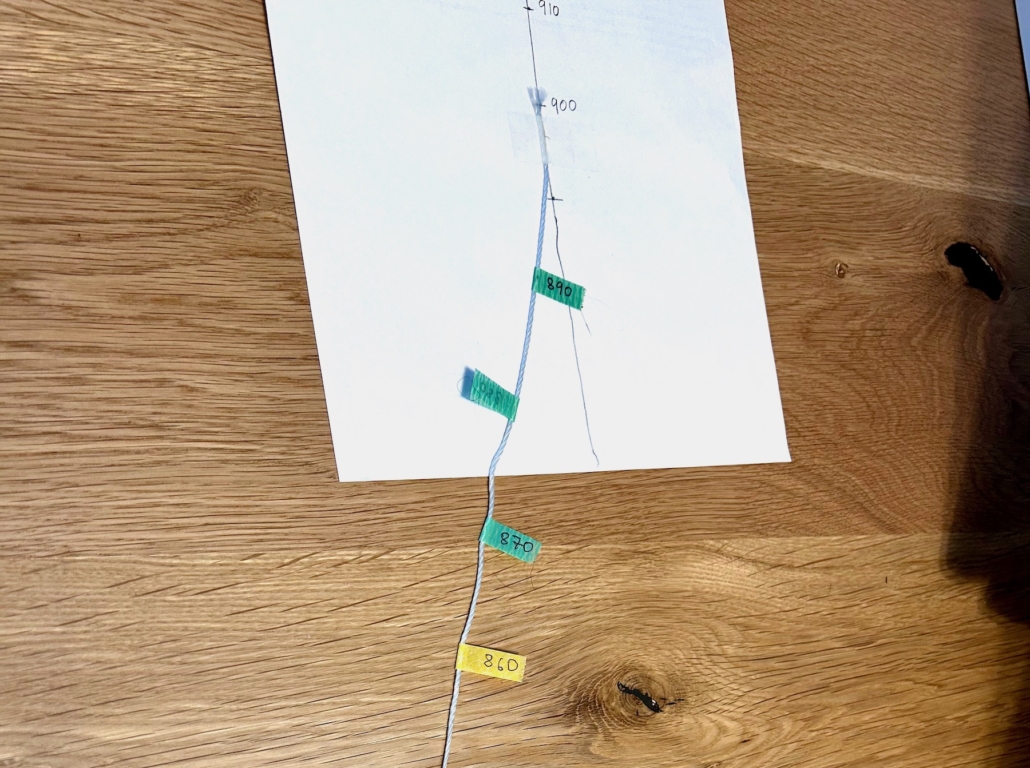
This is how we added the tail on the end for a much longer timeline that wasn’t too cumbersome. At the far end were markers every thousand years.
Multiple Viewpoints
Through reading and social studies lessons, we began our timelines with the standard history framework, or what was repeated in online searches or textbooks. In-country, while visiting monuments, museums, and other historical sites, we began to understand a sense of what this place holds to be important. As a family, we decided what new things we learned that should be added. We divided up the events and added them periodically.
We began asking the people we met what they thought were the most important or pivotal events in their country’s history. We then researched each one as we put it on our timeline. In this way, we began learning “from rather than about” other people and cultures. Traditional classroom learning tends to use secondary sources and someone else’s interpretation of what is important. As you travel, primary sources are all around you!
We attempted to seize this incredible opportunity and asked a broad range of people within the country: Uber drivers, doctors, family friends, indigenous peoples, Airbnb hosts, restaurant servers, etc. We tried to see where there was overlap and where there were differences from our secondary sources. In other words, we compared our interviews (primary sources) to the canon, what was included in Wikipedia or an AI response (secondary sources).
Depending on your kids’ ages and interests, there are endless opportunities for critical thinking here. Deciding what gets included on the timeline is great fodder for discussion, negotiation, and compromise.
A Few of Our A-ha’s
As you begin to fill in the countries and their events, visible themes emerge. Here are some of ours based on our travels:
- Costa Rica’s abolishment of their army was the same era as New Zealand’s ban on nuclear subs. The Cold War might have been an important factor.
- Universal suffrage ranged more than 100 years. While we were in New Zealand, they had a female prime minister which might reflect that they were the first country to grant women the right to vote. Perhaps we might see the 150-year spread between suffrage and female presidents in other countries.
- WWII was included as “important” to most people in every country we visited.
- Indigenous rights movements were not synchronous. Again, New Zealand was early in its support.
- “Developed” and “undeveloped” countries were not static. For example, when China was building palaces and making scientific discoveries, Europe was in its Dark Ages. When the “West” was enjoying a very high standard of living in the 20th century, some of those other countries were considered “less developed” by some metrics. Change is the only constant.
Ways to Riff
There are so many ways to individualize a traveling timeline. You might change the scale and focus on geologic time. Other themes could be innovation and technology, art, military history, or sports.
Creating a timeline for a novel or nonfiction book is a great way to expand and apply to a new context. It’s also useful for biographies or political movements.
You could add artwork for each event, or decorate the borders or century markers.
Also, there are many new applications for mapping or diagramming on computers these days that would solve the need for actual paper that travels. I’ve listed some above (Word, Canva, edrawmax and smartsheet.) We’d love to hear how you have used timelines or plan to use them in the future!
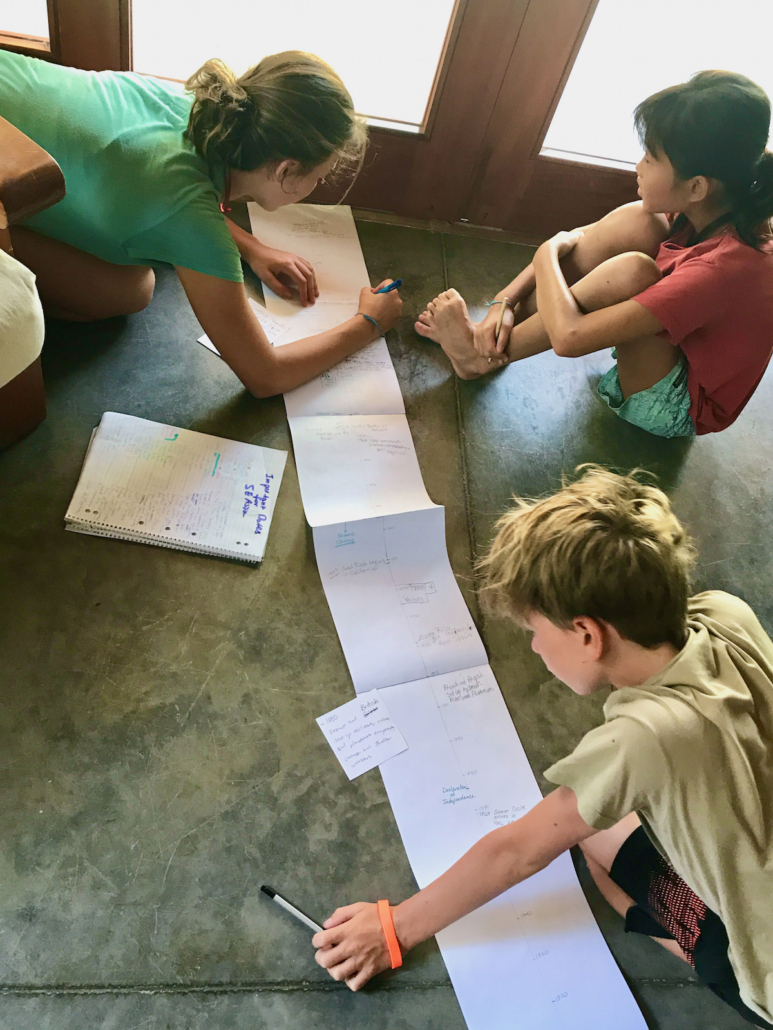
Real family learning! Our traveling timeline brought so much deep discussion and shared discoveries.
